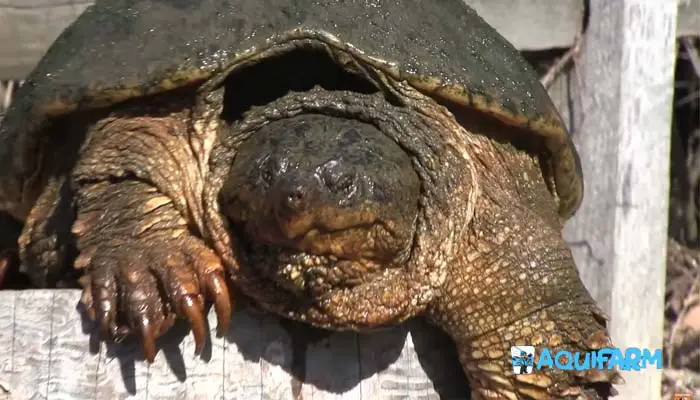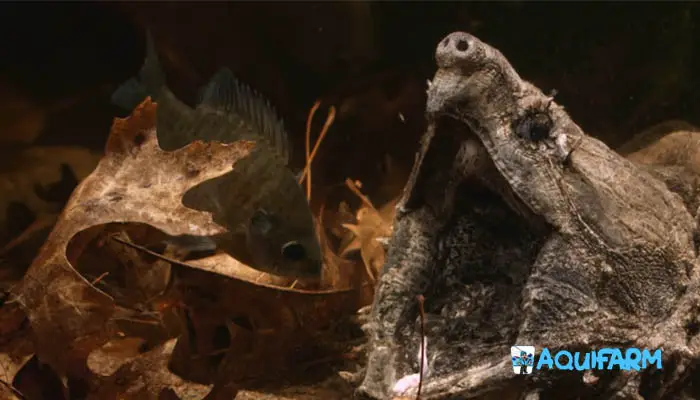4 Causes of Alligator Snapping Turtle Not Eating – Treatment & Prevention
It is certainly a matter of concern if your precious alligator snapping turtle is not eating. Questions may come to mind about why it’s refusing food and what the consequences might be if it remains off-feed for too long.
Turtles can be challenging to feed. Many owners struggle with appetite slumps. When they are not brumating (often called “hibernating” in reptiles), it’s usually okay if they don’t eat for up to one week. If it’s longer than that, you should start investigating the cause.
There can be several reasons your alligator snapping turtle isn’t eating. The most common is sub-optimal environmental conditions (temperature, lighting/UVB, water quality, and enclosure stress).
Illness is another possibility you might not notice at first. Whatever the reason, the end goal is the same — identify the cause and get your turtle eating again.
I had the same issue with my alligator snapping turtle a couple of times. After research and adjustments, I got him back to normal. In this article, I’m sharing what I learned and experienced so you can do the same.
Keep reading through the article till the end to help your alligator snapping turtle before it’s too late.
Why Your Alligator Snapping Turtle is Not Eating

We’ve already mentioned the likely reasons. Because environment is the big one, start there — then consider health and stress.
Like other reptiles, alligator snapping turtles can develop issues that suppress appetite and activity. If the situation continues for days, secondary problems (weight loss, dehydration, infections) can follow.
Consequently, the turtle might suffer from dietary deficiencies, respiratory disease, intestinal parasites, eye issues, or systemic infections.
To complicate things, turtles often hide symptoms. Owners may not notice until the turtle stops eating. Careful inspection is your first step.
Inspecting Why Your Alligator Snapping Turtle is Not Eating
Because symptoms are often subtle, a quick checkup helps you pinpoint the cause. Since environmental conditions are the most common trigger, start here.
1. Determine the Temperature
As a reptile, your alligator snapping turtle is ectothermic (cold-blooded). It relies on external heat to keep metabolism active. If it’s too cool, many turtles reduce or stop eating.
Maintain correct water and ambient temperatures:
• Water (juveniles): ~75–80°F (24–27°C)
• Water (adults): ~70–75°F (21–24°C)
• Ambient cool side: 68–72°F (20–22°C)
• Ambient warm area: ~85°F (29°C)
• Optional haul-out/basking spot: 75–85°F (24–29°C)
Use a reliable digital thermometer and an in-tank probe. Prolonged incorrect temps weaken immunity and raise the risk of respiratory infections.
So, always monitor temperature and adjust promptly. (Our pick: AQUANEAT Aquarium Thermometer)
2. Determine Light Intensity
Adequate lighting supports appetite and overall health. Provide a day–night cycle with both UVA and UVB exposure for about 12–14 hours daily. UVB output (5.0–10.0) aids vitamin D3 synthesis and calcium use.
Too little light can suppress feeding. Replace UVB bulbs every ~6 months (output declines before the bulb burns out). If your turtle is outdoors, you may still need supplemental light in winter or during overcast periods.
3. Is It in Hibernation?
Did you know alligator snapping turtles do not undergo true hibernation? They may brumate (a cool-season slowdown) where metabolism and appetite drop. In captivity, intentional brumation should be done only by experienced keepers or under veterinary guidance.
If you choose seasonal cooling:
• Lower temps gradually by 2–3°F per day to simulate winter.
• Shorten day length to mimic shorter daylight hours.
• Do not let water temps drop below ~55°F (13°C).
• After 8–10 weeks, gradually return to normal temps and photoperiod.
Never force-feed during brumation; it’s stressful and dangerous.
4. Detect Symptoms of Sickness
If environment looks good but a baby or adult snapping turtle still won’t eat, consider illness: constipation/impaction, vitamin deficiencies, eye problems, respiratory infections, internal parasites, or (in females) egg retention.
If you notice lethargy, odd buoyancy, or visible abnormalities, contact a qualified reptile vet promptly.
Discoloration
A whitish, patchy shell can be shell fungus or mineral deposits; flaky skin or swollen eyes can reflect vitamin A deficiency. Both can reduce appetite and require targeted care.
No Excretion
Little or no stool can signal constipation or impaction (often from low temps, dehydration, or swallowing substrate). Correct temps and provide proper hydration; seek a vet if it persists.
Infection
Respiratory infections present with labored breathing, wheezing, nasal discharge, swollen eyes, weakness, and anorexia. Immediate veterinary care is advised.
Not Seeing
Eye debris, infection, or vitamin A deficiency can impair vision — and a turtle that can’t see food often won’t eat. Address the cause and keep the water pristine.
How You Will Feed Your Alligator Snapping Turtle

Every alligator snapping turtle is different, so feeding preferences vary. Even same-age turtles can eat differently. Your job is to discover what yours prefers while keeping nutrition balanced.
When appetite dips, use gentle, enticing methods. Alligator snappers are primarily carnivorous but will take some plant matter. Keep water quality excellent (ammonia 0 ppm, nitrite 0 ppm, nitrate <40 ppm) — dirty water is a top appetite killer.
when it’s time for them to hibernate, providing them with the right food in their diet is a part of regular care for you as a pet keeper. So, if you are wondering what to feed your snapping turtles, here are some ideas for you-
Offer Live Food
Live foods trigger prey drive: worms, crickets, snails, mollusks, small fish, and the occasional pinky mouse. Strong scent often jump-starts feeding.
Tips
- Source earthworms from chemical-free areas or reputable bait shops.
- Avoid frequent feeder goldfish — many contain thiaminase and can deplete vitamin B1.
- Rotating grubs, beetles, roaches, and flies keeps interest high.
- Never force-feed during brumation; resume normal temps first.
Offer Colorful Food
Bright foods can catch the eye: tomato, red/yellow bell pepper, squash, strawberries, watermelon, papaya, mango, and similar produce.
Tips
- Fruits are stimulants, not staples — offer sparingly.
- Favor colorful vegetables (bell pepper, carrot, squash, leafy greens). Soak veggies or pellets in tuna water to boost scent.
- Mix bright produce with a small portion of live food to create a “trail” toward the main meal.
Try Out Food Combinations
Combining high-quality turtle pellets with seafood (krill, shrimp, mussel), worms, or fish pieces can restore interest.
Pellets should anchor the diet; they’re balanced and easy to digest.
Tips
- Pre-soak pellets in tuna water or clam juice for extra scent.
- Offer food in water on feeding tongs; many snappers prefer eating submerged.
Make Changes in the Diet
A repetitive menu can cause refusal. Rotate proteins and presentation (floating vs. tongs vs. dish).
Tips
- Keep a simple log of what works and what doesn’t.
- Note whether your turtle feeds better in water or on a shallow platform.
- Aim for variety across weeks, not every single meal.
Make Changes in the Schedule
Timing matters. Many turtles are most responsive early in the morning or just after lights on.
Tips
- Try feeding near dawn (4:30–5:30 a.m.) or shortly after the photoperiod begins.
- In winter, shift the window to when your turtle is most active.
- Juveniles generally eat every 1–2 days; adults often do well 2× per week.
Take the Turtle to the Veterinarian
If weight loss continues or nothing works, see a reptile (herp) veterinarian. Prolonged starvation can be fatal.
Periodic professional checkups help detect parasites, vitamin deficiencies, and infections before they suppress appetite.
Tips
- Look for a certified herp vet first; if unavailable, contact a local zoo for referrals.
- Universities with veterinary programs often have exotic-animal services.
How to Prevent Your Alligator Snapping Turtle from Not Eating
Prevention is easier than treatment. If you suspect your turtle might go off food, act early. Here’s what helps most.
Know What the Turtle Does Not Like
Every turtle has dislikes. Offering the same rejected item repeatedly teaches avoidance. Provide a variety and observe true preferences.
Also, avoid the following foods:
- Dairy (milk, yogurt, cheese), chocolate
- Refined bread/flour/sugar
- Excessively salty or heavily seasoned foods
- Processed/canned foods and preservatives
- Fruit seeds/pits
- Avocado
- Rhubarb
Ensure a Balanced Diet
Alligator snapping turtles are primarily carnivorous. Aim for roughly 60–90% animal matter and 10–40% plant matter over time. Younger turtles need proportionally more protein than adults.
High-quality pellets, whole aquatic proteins (shrimp, krill, mussels), worms, and occasional fish are ideal. Keep portions reasonable to prevent obesity and fatty-liver disease.
Add Supplement Diet
Supplements can help during recovery: calcium (with D3 if UVB is limited) supports shell and bone. A weekly multivitamin may be useful during appetite slumps, per vet guidance.
Calcium sources include cuttlebone, calcium blocks/powder, or fortified pellets. Avoid over-supplementing — follow label or vet directions.
Final Words
Now that you know why your alligator snapping turtle is not eating — and how to get it eating again — you’re better prepared.
Because pets are precious, watch body condition, activity, and water quality year-round. If appetite drops, review temperature, lighting/UVB, water parameters, filtration, stressors, and diet variety — then act quickly.
The feeding ideas and prevention tips above will help you avoid long fasting periods and keep your turtle thriving.
If our guide helped, please share it — and let us know your questions! If your alligator snapping turtle still won’t eat after these steps, consult a veterinarian for targeted care.
- Honey Gourami Clamped Fins – Expert Guide To Diagnosis, Treatment, And - December 14, 2025
- Gourami Upside Down – Decoding Behavior & Ensuring A Thriving, Healthy - December 14, 2025
- Gourami Swimming Vertically – Deciphering Behavior & Ensuring Health - December 14, 2025
